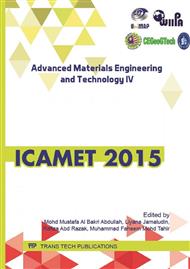[1]
Wallah. S.E. and Rangan B.V. (2006). Low-calcium fly ash-based geopolymer concrete: long-term properties. Res. Report-GC2, Curtin University, Australia. 76-80.
Google Scholar
[2]
Pacheco-Torgal. F., Castro-Gomes. J. and Salali. S. (2008). Alkali-activated binders: A review: Part 1. Historical background, terminology, reaction mechanisms and hydration products. Construction and Building Materials, 22(7), 1305-1314.
DOI: 10.1016/j.conbuildmat.2007.10.015
Google Scholar
[3]
Temuujin. J., Williams. R.P. and Van Riessen. A. (2009). Effect of mechanical activation of fly ash on the properties of geopolymer cured at ambient temperature. Journal of Materials Processing Technology, 209(12), 5276-5280.
DOI: 10.1016/j.jmatprotec.2009.03.016
Google Scholar
[4]
ul Haq. E., Padmanabhan. S.K. and Licciulli. A. (2014). Synthesis and characteristics of fly ash and bottom ash based geopolymers–a comparative study. Ceramics International, 40(2), 2965-2971.
DOI: 10.1016/j.ceramint.2013.10.012
Google Scholar
[5]
Xie. T. and Ozbakkaloglu. T. (2015). Behavior of low-calcium fly and bottom ash-based geopolymer concrete cured at ambient temperature. Ceramics International, 41(4), 5945-5958.
DOI: 10.1016/j.ceramint.2015.01.031
Google Scholar
[6]
Topcu. I. B. and Mehmet U.T. (2011). Properties of geopolymer from circulating fluidized bed combustion coal bottom ash. Materials Science and Engineering A, 528(3), 1472-1477.
DOI: 10.1016/j.msea.2010.10.062
Google Scholar
[7]
Kim. S.H., Ryu. G.S., Koh. K.T. and Lee. J.H. (2012).
Google Scholar
[8]
Santa. R.A.A.B., Bernardin. A.M., Riella. H.G. and Kuhnen. N.C. (2013). Geopolymer synthetized from bottom coal ash and calcined paper sludge. Journal of Cleaner Production, 57, 302-307.
DOI: 10.1016/j.jclepro.2013.05.017
Google Scholar
[9]
Xie. T. and Ozbakkaloglu. T. (2015). Influence of coal ash properties on compressive behaviour of FA-and BA-based GPC. Magazine of Concrete Research, doi: 10. 1680/macr. 14. 00429.
DOI: 10.1680/macr.14.00429
Google Scholar
[10]
Temuujin, J., R. P. Williams., and Van Riessen. A. (2009). Effect of mechanical activation of fly ash on the properties of geopolymer cured at ambient temperature. Journal of Materials Processing Technology, 209(12), 5276-5280.
DOI: 10.1016/j.jmatprotec.2009.03.016
Google Scholar
[11]
Diaz. E.I., Allouche. E. N. and S. Eklund. (2010). Factors affecting the suitability of fly ash as source material for geopolymers. Fuel, 89(5), 992-996.
DOI: 10.1016/j.fuel.2009.09.012
Google Scholar
[12]
De Silva. P., Sagoe-Crenstil. K. and Sirivivatnanon. V. (2007). Kinetics of geopolymerization: role of Al2O3 and SiO2. Cement and Concrete Research, 37(4), 512-518.
DOI: 10.1016/j.cemconres.2007.01.003
Google Scholar
[13]
Temuujin. J., Van Riessen. A. and Williams. R. (2009). Influence of calcium compounds on the mechanical properties of fly ash geopolymer pastes. Journal of hazardous materials, 167(1), 82-88.
DOI: 10.1016/j.jhazmat.2008.12.121
Google Scholar


